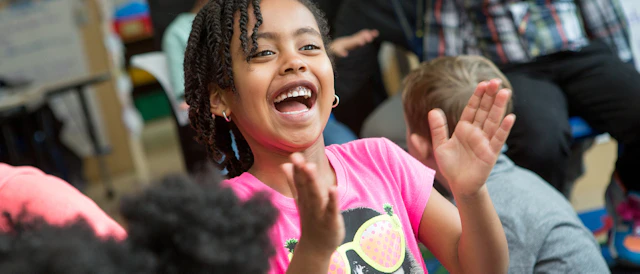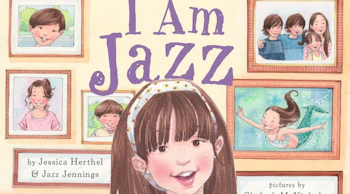

Lesson Plans to Create Gender Expansive Classrooms and Support Transgender and Non-Binary Students
Welcoming Schools teacher-friendly lesson plans were designed to help educators create classrooms and schools that are free of gender stereotypes and gender norms that limit all children.
A key focus of our program is to provide comprehensive resources for educators to teach about transgender and non-binary people and to affirm all students’ identities across the gender spectrum

Be Who You Are with the book by Todd Parr
Be Who You Are by Todd Parr reminds kids that their unique traits are what make them so special. After reading, students will create a detailed drawing of themselves. This book and activity can provide an opportunity to discuss unique identities and gender expression with students. [K - 2]

Red: A Crayon's Story –There's More To Me Than You Can See
Red: A Crayon's Story provides a wonderful opportunity to discuss stereotypes based on appearance (gender, race, ability). Each student will create a self crayon that explores their inner identities. [K - 2]

Gender Snowperson: Understanding Gender Identity
This lesson provides a simple tool to help students understand the differences between gender identity, gender expression, who you love and sex assigned at birth. [3 - 5]

Calvin: Time for Me
Calvin has always been a boy, even if the world sees him as a girl. He knows who he is in his heart and in his mind, but he hasn't yet told his family. Finally, he can wait no longer. [K - 2]

Born Ready: The True Story of a Boy Named Penelope
Penelope's experiences show children that it always makes you stronger when you are true to yourself and who you really are.

I Am Jazz: Understanding Transgender Children
This picture book, I Am Jazz, based on the life of Jazz Jennings, can help start a conversation with students on what it means to be transgender. Listen to Jazz Jennings read I Am Jazz. [K - 5]

From the Stars in the Sky to the Fish in the Sea
In this beautifully imagined picture book about gender, identity, and the acceptance of the differences between us, Miu Lan faces many questions about who they are and who they may be. One thing's for sure: no matter what, their mother will love them. [K - 3]

Creating Community in Your Classroom: I Am Me Poems
After reading Looking Like Me by Walter Dean Myers, students write short poems, modeled after the ideas in the book. This is a great activity to help educators and students to get to know each other better. [3 - 5]

Using Children's Books To Look At Gender Stereotyping
Find a fun way to talk about gender stereotypes and discrimination with activities paired with children's books. [K - 2]

Introducing Teddy: Understanding Gender and Friendship
The book, Introducing Teddy and several fun activities help students understand concepts of gender identity and how to be a kind friend. [K - 2]

Julián Is a Mermaid: Understanding Gender Expression
While in the subway with his abuela, Julián sees three women spectacularly dressed up and wants to dress up just like them. But what will his abuela think? A story about the power of being seen and affirmed. [K - 3]

Persuasive Letters: Examining Gender Marketing by Toy Companies
Students will write persuasive essays after examining and gathering data on gender marketing by toy manufacturers. Students will cultivate media literacy skills to understand how media messaging shapes our culture around gender norms. [3 - 5]

Children Just Like Me: Understanding Gender Expression
Children Just Like Me helps students understand that gender expression can vary personally, culturally and globally. [K - 2]

Jacob's New Dress: Understanding Gender Expression
Through the story of Jacob, students discuss gender expression and mean teasing based on gender. [1 - 2]

Biographies: Courageous, Diverse Role Models for Students
Reach beyond the usual biographies. Find strong women, creative men, and other successful people of all genders to inspire your students. [K - 6]

They, She, He easy as ABC: Understanding Names, Pronouns and Gender Expression
Inclusive pronouns are learned alongside the alphabet. Shows that including everyone is all part of the dance. Meet 26 kids showing us their dance moves. “No one left out and everyone free.” [Pre-K - K]

Media Sleuths: Examining Gender Roles In Advertising
With a quick look at magazines, catalogs or TV, students can see many gender stereotypes. Use the log sheet to record findings, tally results and spark discussions. [3 - 6]

Toy Marketing and Gender: Design a Welcoming Toy Store
Students will work in teams to design a toy store that is sorted by categories other than gender using the students favorite toys. This activity provides many teachable moments to talk about gender norms and gender stereotypes. [1 - 3]

Chimera Butterflies: Non-Binary Animals
Chimera Butterflies and other chimera animals are example of gender diversity in nature. Each student will create their own unique butterfly with asymmetrical wings. [K - 2]

Transgender and Gender Non-Conforming Women of Color: The Stonewall Inn and the Modern LGBTQ Movement
This lesson highlights four transgender and gender non-conforming women of color – Marsha P. Johnson, Sylvia Rivera, Miss Major and Stormé DeLarverie and their role in transgender and LGBTQ history. [5 - 8]

They, She, He, Me, Free to Be! Understanding Pronouns
They, She, He, Me Free To Be! is a short diverse book about pronouns and gender expression. Student can also create an artistic pronoun to display in your classroom. [2 - 5]

Call Me Tree/Llámame árbol: Exploring a Gender Free Book
Call Me Tree / Llámame árbol is a short book written in verse. It offers an opportunity to build classroom community by giving students a chance to learn about gender via a character in a book who does not use pronouns. There is also a movement break incorporated into this lesson so that children can learn and practice the tree pose in yoga. [K - 2]

Modern Fairy Tales: Writing and Expanding Gender
Compare traditional fairy tales with modern fairy tales to examine ways fairy tales reinforce or disrupt gender stereotypes. Students can then do a quick write or develop a longer story of their own that explores gender. [3 - 5]

Backwards Day: Reading a Children's Book to Understand Transgender Topics in Elementary School
Backwards Day is an engaging children’s book that features a transgender character named Andy. It is fun to notice interesting details in the book with your students such as how the pages are numbered backwards while learning about what it can mean to be transgender, non-binary or gender expansive.[2 - 5]


